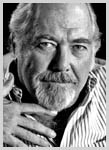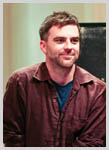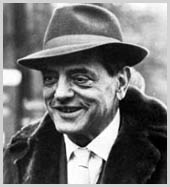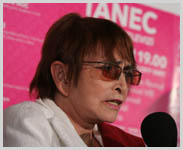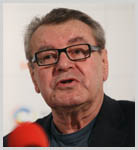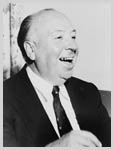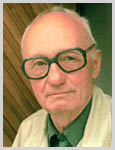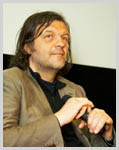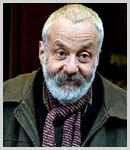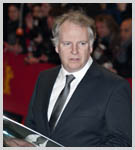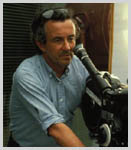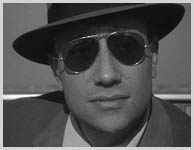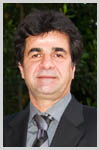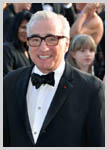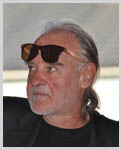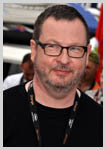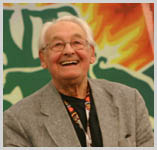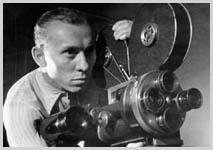



Suggested Viewing:
| MASH | Brewster McCloud | ||
| McCabe & Mrs. Miller | Images | ||
| The Long Goodbye | Nashville | ||
| 3 Women | The Player | ||
| Short Cuts | Gosford Park | ||
| A Prairie Home Companion |
Field Notes:
Worked in many genres, turning most of them on their heads in the process
Managed to make unconventional films, even when working within Hollywood studio system, by taking care to avoid drawing executives’ attention to the movies he had in production, and to their budgets
Several of his movies feature remarkably large casts of major characters, though Secret Honor is notably a 90-minute monologue with a cast of one
“I fiddle in the corner where they throw the coins. Where I can get my work done.”








Director Dossiers








These directors have won the Dingo’s Film Strip of
Splenditude, unbeknownst to them, as care has been taken to
ensure the award is highly prestigious, yet virtually unknown,
in what is one of the great paradoxical achievements
of our time.








Directory of Directors
Click Name to See Dossier




 |
 |
 |
 |
||||||||
 |
 |
 |
|||||||||
 |
 |
 |
 |
||||||||
 |
Photo by |
|
 |
 |
 |
||||||
 |
Date of Birth: |
Feb 20, 1925 |
 |
 |
 |
||||||
 |
Date of Death: |
Nov 20, 2006 |
 |
 |
 |
||||||
 |
 |
 |
|||||||||
 |
Suggested Viewing: |
 |
|||||||||
 |
 |
 |
|||||||||
 |
 |
 |
|||||||||
 |
Notes: |
Worked in many genres, turning most of them on their heads in the process |
 |
||||||||
 |
 |
Managed to make unconventional films, within the Hollywood studio system, by making a point of not drawing attention to the productions |
 |
||||||||
 |
 |
Several of his movies feature larger than usual casts of major characters, though Secret Honor is notably a 90-minute monologue with a cast of one |
 |
||||||||
 |
 |
 |
|||||||||
 |
 |
 |
 |
|||
 |
 |
 |
||||
 |
 |
 |
 |
|||
 |
Photo by |
Place of Origin: |
USA |
 |
 |
 |
 |
Date of Birth: |
Jun 26, 1970 |
 |
 |
 |
|
 |
Date of Death: |
 |
 |
 |
 |
|
 |
 |
 |
||||
 |
Suggested Viewing: |
 |
||||
 |
 |
 |
||||
 |
Notes: |
Often makes long movies with large casts and multiple intertwining storylines, not unlike many of the films made by Robert Altman |
 |
|||
 |
 |
Uses long shots more than what is typical for his generation of American filmmakers |
 |
|||
 |
 |
Four of his first six feature films were nominated for Oscars, but none of them won |
 |
|||
 |
 |
 |
||||
 |
 |
 |
||||
 |
 |
 |
||||
 |
 |
 |
||||
 |
Place of Origin: |
Spain |
 |
 |
 |
|
 |
Date of Birth: |
Feb 22, 1900 |
 |
 |
 |
|
 |
Date of Death: |
Jul 29, 1983 |
 |
 |
 |
|
 |
 |
 |
||||
 |
Suggested Viewing: |
 |
||||
 |
 |
 |
||||
 |
 |
 |
||||
 |
Notes: |
The so-called father of surrealist cinema, which is considered to have been born with the release of his short film, Un chien andalou, in 1929 |
 |
|||
 |
 |
Disaffected, yet obsessed with the Church following a strict religious upbringing, Buñuel often used his films to mock or criticize Catholicism |
 |
|||
 |
 |
His tendency to offend and enrage members of the establishment resulted in a career divided into several periods, based on where he was able to work: France, Spain, America, Mexico, and again in France |
 |
|||
 |
 |
 |
||||
 |
 |
 |
 |
|||
 |
 |
 |
||||
 |
 |
 |
 |
|||
 |
Photo by |
Place of Origin: |
Caechoslovakia |
 |
 |
 |
 |
Date of Birth: |
Feb 2, 1929 |
 |
 |
 |
|
 |
Date of Death: |
Mar 12, 2014 |
 |
 |
 |
|
 |
 |
 |
||||
 |
Suggested Viewing: |
 |
||||
 |
 |
 |
||||
 |
Notes: |
Wrote letters to various officials, suggesting that because two government ministers had decided to cancel the partly completed production of her film Kalamita (Calamity), the money already spent on the film should be deducted from their salaries. Production resumed one week later. |
 |
|||
 |
 |
Sometimes made vague films that were small on story, big on art, because she was fascinated by differences in people’s perceptions and interpretations, claiming that the interesting thing was not a movie’s plot details, but what it made people think. |
 |
|||
 |
 |
Was the subject of Cesta (Journey), a biography / interview documentary, in which she speaks extensively on her life and her philosophies regarding cinema and many other things. |
 |
|||
 |
 |
 |
||||
 |
 |
 |
||||
 |
 |
 |
||||
 |
 |
 |
||||
 |
Photo by |
Place of Origin: |
Czechoslovakia |
 |
 |
 |
 |
Date of Birth: |
Feb 18, 1932 |
 |
 |
 |
|
 |
Date of Death: |
 |
 |
 |
 |
|
 |
 |
 |
||||
 |
Suggested Viewing: |
 |
||||
 |
 |
 |
||||
 |
 |
 |
||||
 |
Notes: |
One of the first Czechoslovak New Wave directors (arguably THE first), and the most successful, having won five Oscars |
 |
|||
 |
 |
Cast a variety of unknown and non-professional actors in his early films, including the film that swept the five top Oscar categories, One Flew Over the Cuckoo’s Nest, which had only one actor who was well-known at the time it was made |
 |
|||
 |
 |
Emigrated to America, rather than give up his film career, when Czechoslovakia was invaded by Warsaw Pact armies, intent on suppressing the liberal reforms of the Prague Spring, in 1968 |
 |
|||
 |
 |
 |
||||
 |
 |
 |
||||
 |
 |
 |
||||
 |
 |
 |
||||
 |
Photo by |
Place of Origin: |
UK |
 |
 |
 |
 |
Date of Birth: |
Apr 5, 1942 |
 |
 |
 |
|
 |
Date of Death: |
 |
 |
 |
 |
|
 |
 |
 |
||||
 |
Suggested Viewing: |
 |
||||
 |
 |
 |
||||
 |
 |
 |
||||
 |
Notes: |
Having pursued painting before filmmaking, his camera shots are composed like paintings, at times in the styles of Vermeer or Rembrandt |
 |
|||
 |
 |
Often presents film content in the form of lists |
 |
|||
 |
 |
Known for directing movies that are intellectual treatments of matters that are taboo, offensive, shocking, or merely uncomfortable |
 |
|||
 |
 |
 |
||||
 |
 |
 |
 |
|||
 |
 |
 |
||||
 |
 |
 |
 |
|||
 |
Photo by |
Place of Origin: |
Germany |
 |
 |
 |
 |
Date of Birth: |
Sep 5, 1942 |
 |
 |
 |
|
 |
Date of Death: |
|
 |
 |
 |
|
 |
 |
 |
||||
 |
Suggested Viewing: |
 |
||||
 |
 |
 |
||||
 |
 |
 |
||||
 |
 |
 |
||||
 |
 |
 |
||||
 |
Notes: |
Makes liberal use of stunning landscapes and various natural wonders |
 |
|||
 |
 |
Has a tendency to go off on odd tangents, especially in his documentaries |
 |
|||
 |
 |
Can be considered armed and dangerous after threatening to shoot actor Klaus Kinski, who declared his intention to abandon Aguirre, der Zorn Gottes (Aguirre: The Wrath of God) before the movie was complete |
 |
|||
 |
 |
 |
||||
 |
 |
 |
 |
|||
 |
 |
 |
||||
 |
 |
 |
 |
|||
 |
Photo by |
Place of Origin: |
UK |
 |
 |
 |
 |
Date of Birth: |
Aug 13, 1899 |
 |
 |
 |
|
 |
Date of Death: |
Apr 29, 1980 |
 |
 |
 |
|
 |
 |
 |
||||
 |
Suggested Viewing: |
 |
||||
 |
 |
 |
||||
 |
 |
 |
||||
 |
 |
 |
||||
 |
 |
 |
||||
 |
 |
 |
||||
 |
Notes: |
Advocate of a “pure cinema” concept, in which information is given to viewers via images, instead of dialog, whenever reasonably possible |
 |
|||
 |
 |
One of cinema’s move prolific directors, having directed over 50 feature films in his career |
 |
|||
 |
 |
Was locked in a jail cell for 10 minutes when he was a child, at the request of his father, who wanted him to learn what happens to people who do bad things |
 |
|||
 |
 |
 |
||||
 |
 |
 |
||||
 |
 |
 |
||||
 |
 |
 |
||||
 |
Place of Origin: |
Czechoslovakia |
 |
 |
 |
|
 |
Date of Birth: |
May 1, 1924 |
 |
 |
 |
|
 |
Date of Death: |
Mar 12, 2004 |
 |
 |
 |
|
 |
 |
 |
||||
 |
Suggested Viewing: |
 |
||||
 |
 |
 |
||||
 |
Notes: |
Trained as a cinematographer before he got into directing, and is thus not surprisingly well reputed for making making suberbly photographed films |
 |
|||
 |
 |
Came from the generation before most Czechoslovak New Wave directors, but fit in well with the movement, banned films and all |
 |
|||
 |
 |
Collaboration with writer Jan Procházka, who was well connected within the communist party, enabled greater than usual latitude for criticism of the government |
 |
|||
 |
 |
 |
||||
 |
 |
 |
 |
|||
 |
 |
 |
||||
 |
 |
 |
 |
|||
 |
Photo by |
Place of Origin: |
Poland |
 |
 |
 |
 |
Date of Birth: |
Jun 27, 1941 |
 |
 |
 |
|
 |
Date of Death: |
Mar 13, 1996 |
 |
 |
 |
|
 |
 |
 |
||||
 |
Suggested Viewing: |
 |
||||
 |
 |
 |
||||
 |
 |
 |
||||
 |
 |
 |
||||
 |
Notes: |
Rejected twice by the Łódź Film School, but was finally accepted upon his third attempt |
 |
|||
 |
 |
Considered part of the Cinema of Moral Anxiety movement that depicted the realities of Polish life under communism, which made the Polish communist governmenent none too happy |
 |
|||
 |
 |
Started out as a documentary filmmaker, and eventually branched out into the world of narrative fiction |
 |
|||
 |
 |
 |
||||
 |
 |
 |
||||
 |
 |
 |
||||
 |
 |
 |
||||
 |
Photo by |
Place of Origin: |
Yugoslavia |
 |
 |
 |
 |
Date of Birth: |
Nov 24, 1954 |
 |
 |
 |
|
 |
Date of Death: |
 |
 |
 |
 |
|
 |
 |
 |
||||
 |
Suggested Viewing: |
 |
||||
 |
 |
 |
||||
 |
Notes: |
Music plays a big part in his films, in which every quiet moment carries a strong liklihood of a Gypsy band materializing, seemingly out of nowhere, and launching into a spirited rendition of a well-loved Romani tune |
 |
|||
 |
 |
May be the only director to include a crying lovesick donkey with a death wish as an important character in a movie, however, Robert Bresson is unavailable for comment as to Balthazar’s true emotional state, which was concealed by an especially stoic performance |
 |
|||
 |
 |
Acts in films and plays in a rock band when not directing his own movies |
 |
|||
 |
 |
 |
||||
 |
 |
 |
 |
|||
 |
 |
 |
||||
 |
 |
 |
 |
|||
 |
Photo by |
Place of Origin: |
UK |
 |
 |
 |
 |
Date of Birth: |
Feb 20, 1943 |
 |
 |
 |
|
 |
Date of Death: |
|
 |
 |
 |
|
 |
 |
 |
||||
 |
Suggested Viewing: |
 |
||||
 |
 |
 |
||||
 |
 |
 |
||||
 |
Notes: |
Works with actors to develop their characters and dialogue through improvisation, instead of presenting the actors with scripts as is the norm |
 |
|||
 |
 |
Asks that actors learn how to perform the jobs done by their characters, if they are to be depicted at work |
 |
|||
 |
 |
Commonly uses a slice-of-life narrative form, which depicts people’s lives over a certain period of time, with no definite beginning or end to their stories |
 |
|||
 |
 |
 |
||||
 |
 |
 |
||||
 |
 |
 |
||||
 |
 |
 |
||||
 |
Photo by |
Place of Origin: |
Canada |
 |
 |
 |
 |
Date of Birth: |
Feb 28, 1956 |
 |
 |
 |
|
 |
Date of Death: |
 |
 |
 |
 |
|
 |
 |
 |
||||
 |
Suggested Viewing: |
 |
||||
 |
 |
 |
||||
 |
 |
 |
||||
 |
Notes: |
Makes contemporary movies that harken back to the silent era |
 |
|||
 |
 |
Known to obscure the images and audio in his films using things like snow, static, feathers, broken camera lenses, vinyl record crackling, and color tinting/toning |
 |
|||
 |
 |
Has a flair for melodrama and depravity |
 |
|||
 |
 |
 |
||||
 |
 |
 |
||||
 |
 |
 |
||||
 |
 |
 |
 |
|||
 |
Place of Origin: |
France |
 |
 |
 |
|
 |
Date of Birth: |
Oct 30, 1932 |
 |
 |
 |
|
 |
Date of Death: |
Nov 23, 1995 |
 |
 |
 |
|
 |
 |
 |
||||
 |
Suggested Viewing: |
 |
||||
 |
 |
 |
||||
 |
 |
 |
||||
 |
 |
 |
||||
 |
 |
 |
||||
 |
Notes: |
Because he made a concerted effort to avoid repeating himself, Malle’s oeuvre is a diverse collection of films, which cannot be pinned down to any particular genre or style |
 |
|||
 |
 |
While usually not a controversial director, he sometimes took on subject matter that was considered taboo, such as adultery, suicide, incest, and child prostitution |
 |
|||
 |
 |
His movie Les Amants (The Lovers) was the subject of Jacobellis v. Ohio, a landmark obscenity case heard by the United States Supreme Court, and found to be not obscene by a majority of the Justices, including Potter Stewart, who wrote in his opinion the famous line about the definition of obscenity, “I’ll know it when I see it.” |
 |
|||
 |
 |
 |
||||
 |
 |
 |
 |
|||
 |
 |
 |
||||
 |
 |
 |
 |
|||
 |
Place of Origin: |
France |
 |
 |
 |
|
 |
Date of Birth: |
Oct 20, 1917 |
 |
 |
 |
|
 |
Date of Death: |
Aug 2, 1973 |
 |
 |
 |
|
 |
 |
 |
||||
 |
Suggested Viewing: |
 |
||||
 |
 |
 |
||||
 |
 |
 |
||||
 |
Notes: |
Born with the last name Grumbach, he took on the pseudonym “Melville” while he was a member of the French Resistance during WWII |
 |
|||
 |
 |
Began his filmmaking career outside of the French studio system, because he was initially rejected by the French Technicians’ Union |
 |
|||
 |
 |
Played a small role in the French New Wave sensation, À bout de souffle (Breathless), directed by Jean-Luc Godard |
 |
|||
 |
 |
 |
||||
 |
 |
 |
 |
|||
 |
 |
 |
||||
 |
 |
 |
 |
|||
 |
Photo by |
Place of Origin: |
Iran |
 |
 |
 |
 |
Date of Birth: |
Jul 11, 1960 |
 |
 |
 |
|
 |
Date of Death: |
|
 |
 |
 |
|
 |
 |
 |
||||
 |
Suggested Viewing: |
 |
||||
 |
 |
 |
||||
 |
Notes: |
Arrested in 2010 for “making a film against the regime” about the events following the 2009 election in Iran, and sentenced to six years in prison and banned from filmmaking, political activity, travel, and giving interviews for 20 years. |
 |
|||
 |
 |
A flash drive containing his movie entitled In film nist (This Is Not a Film), which was produced while Panahi was under house arrest, was smuggled out of Iran in a cake |
 |
|||
 |
 |
Has a humanist worldview that is considered unacceptable by Iran’s Ministry of Culture and Islamic Guidance |
 |
|||
 |
 |
 |
||||
 |
 |
 |
 |
|||
 |
 |
 |
||||
 |
 |
 |
 |
|||
 |
Photo by |
Place of Origin: |
USA |
 |
 |
 |
 |
Date of Birth: |
Nov 17, 1942 |
 |
 |
 |
|
 |
Date of Death: |
|
 |
 |
 |
|
 |
 |
 |
||||
 |
Suggested Viewing: |
 |
||||
 |
 |
 |
||||
 |
 |
 |
||||
 |
Notes: |
Graduated from NYU School of Film with an M.A. and went on to teach there, with Oliver Stone and Spike Lee among his students |
 |
|||
 |
 |
Teamed up with Jerry Garcia and Francis Ford Coppola to locate and restore an extremely hard to find, un-cut print of Rekopis znaleziony w Saragossie (The Saragossa Manuscript), which had not been seen in America for over 20 years |
 |
|||
 |
 |
Often sets his films in New York City, where he was born and raised |
 |
|||
 |
 |
 |
||||
 |
 |
 |
 |
|||
 |
 |
 |
||||
 |
 |
 |
 |
|||
 |
Photo by |
Place of Origin: |
Hungary |
 |
 |
 |
 |
Date of Birth: |
Jul 21, 1955 |
 |
 |
 |
|
 |
Date of Death: |
 |
 |
 |
 |
|
 |
 |
 |
||||
 |
Suggested Viewing: |
 |
||||
 |
 |
 |
||||
 |
Notes: |
Makes heavy use of unusually long shots, with durations measured not in seconds, but in minutes, well in excess of what most filmmakers would consider reasonable, much less customary |
 |
|||
 |
 |
Best known for the style he employed in the latter part of his career, beginning with his film, Kárhozat (Damnation) |
 |
|||
 |
 |
Likes to include accordion music in his movies |
 |
|||
 |
 |
 |
||||
 |
 |
 |
||||
 |
 |
 |
||||
 |
 |
 |
||||
 |
Photo by |
Place of Origin: |
Denmark |
 |
 |
 |
 |
Date of Birth: |
Apr 30, 1956 |
 |
 |
 |
|
 |
Date of Death: |
 |
 |
 |
 |
|
 |
 |
 |
||||
 |
Suggested Viewing: |
 |
||||
 |
 |
 |
||||
 |
Notes: |
Co-wrote, with director Thomas Vinterberg, the Dogme 95 Manifesto, which is a set of rules for a very raw, natural type of filmmaking, but usually breaks some or all of the rules when making films. |
 |
|||
 |
 |
Many of his films are designed to elicit strong emotional reactions from viewers |
 |
|||
 |
 |
Claims to be afraid of almost everything other than making movies |
 |
|||
 |
 |
 |
||||
 |
 |
 |
||||
 |
 |
 |
||||
 |
 |
 |
||||
 |
Photo by |
Place of Origin: |
Poland |
 |
 |
 |
 |
Date of Birth: |
Mar 6, 1926 |
 |
 |
 |
|
 |
Date of Death: |
 |
 |
 |
 |
|
 |
 |
 |
||||
 |
Suggested Viewing: |
 |
||||
 |
 |
 |
||||
 |
 |
 |
||||
 |
Notes: |
Four of Wajda’s movies have been nominated for the Best Foreign Language Oscar, and he received the European Film Award for Lifetime Achievement in 1990, a Golden Bear for Lifetime Achievement in 2006, and various other significant honors |
 |
|||
 |
 |
Stealthily criticized the communist establishment using allusion and metaphor, eventually becoming more overt and getting himself into trouble with the government |
 |
|||
 |
 |
Showed his support for Polish Solidarity in his film Człowiek z żelaza (Man of Iron) |
 |
|||
 |
 |
 |
||||
 |
 |
 |
||||
 |
 |
 |
||||
 |
 |
 |
||||
 |
Photo courtesy of |
Place of Origin: |
Bohemia |
 |
 |
 |
 |
Date of Birth: |
Nov 3, 1910 |
 |
 |
 |
|
 |
Date of Death: |
Nov 20, 2006 |
 |
 |
 |
|
 |
 |
 |
||||
 |
Suggested Viewing: |
 |
||||
 |
 |
 |
||||
 |
 |
 |
||||
 |
Notes: |
Regarded as a master of special effects long before computer animation and digital video processing existed. |
 |
|||
 |
 |
Known for combining live action, animation, models, matte drawings, and still photos with impressive results. |
 |
|||
 |
 |
Inspired and influenced the work of notable directors, such as Terry Gilliam, Tim Burton, and Wes Anderson, yet remains largely unknown to American moviegoers. |
 |
|||
 |
 |
 |
||||
Copyright © 2014 - 2018, All Rights Reserved
—————-





